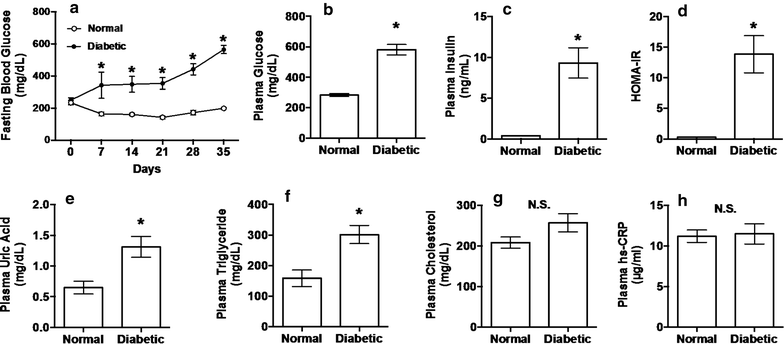Hyperuricemia in type 2 diabetic model KK-Ay/Ta mice: a potent animal model with positive correlation between insulin resistance and plasma high uric acid levels
- PMID: 29115981
- PMCID: PMC5678565
- DOI: 10.1186/s13104-017-2897-x
Hyperuricemia in type 2 diabetic model KK-Ay/Ta mice: a potent animal model with positive correlation between insulin resistance and plasma high uric acid levels
Abstract
Objective: Hyperuricemia is recognized as a main cause of gout. Accumulating clinical evidence suggests that hyperuricemia is strongly associated with insulin resistance and abnormal glucose metabolism. However, there seem no proper animal models for investigating such associations. Ideal animal model is considered to be hyperuricemic as well as diabetic. Selecting the KK-Ay/Ta mouse model, the relationship between hyperuricemia and insulin resistance has been studied to characterize such an animal model.
Results: Male type 2 diabetic KK-Ay/Ta and age-matched normal C57BL/6J mice were maintained on a basal 20% casein diet for 35 days. Food intake, body weight gain, levels of plasma uric acid, glucose, insulin, homeostasis model assessment of insulin resistance (HOMA-IR), and triglyceride in KK-Ay/Ta mice were significantly higher than those in normal mice. Plasma uric acid levels showed significant positive correlations with plasma glucose, insulin, HOMA-IR and triglyceride levels. These results suggest that the KK-Ay/Ta mouse strain is useful for studies on correlation between hyperuricemia and insulin resistance, and for those on effects of foods and their components on the relations.
Keywords: Hyperglycemia; Hyperuricemia; Insulin resistance; KK-Ay/Ta mouse.
Figures


References
MeSH terms
Substances
LinkOut - more resources
Full Text Sources
Other Literature Sources
Molecular Biology Databases

